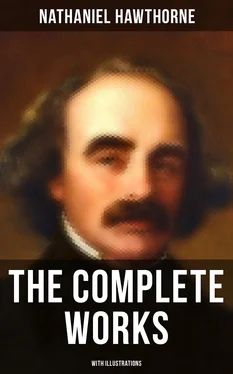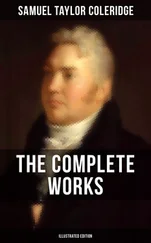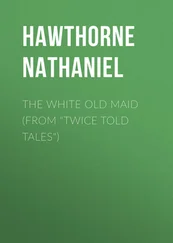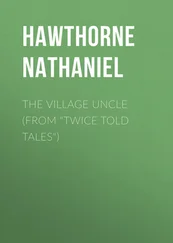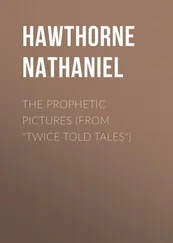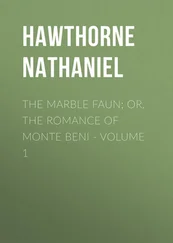CHAPTER IV
THE SPECTRE OF THE CATACOMB
Table of Contents
“Surely, she cannot be lost!” exclaimed Kenyon. “It is but a moment since she was speaking.”
“No, no!” said Hilda, in great alarm. “She was behind us all; and it is a long while since we have heard her voice!”
“Torches! torches!” cried Donatello desperately. “I will seek her, be the darkness ever so dismal!”
But the guide held him back, and assured them all that there was no possibility of assisting their lost companion, unless by shouting at the very top of their voices. As the sound would go very far along these close and narrow passages, there was a fair probability that Miriam might hear the call, and be able to retrace her steps.
Accordingly, they all — Kenyon with his bass voice; Donatello with his tenor; the guide with that high and hard Italian cry, which makes the streets of Rome so resonant; and Hilda with her slender scream, piercing farther than the united uproar of the rest — began to shriek, halloo, and bellow, with the utmost force of their lungs. And, not to prolong the reader’s suspense (for we do not particularly seek to interest him in this scene, telling it only on account of the trouble and strange entanglement which followed), they soon heard a responsive call, in a female voice.
“It was the signorina!” cried Donatello joyfully.
“Yes; it was certainly dear Miriam’s voice,” said Hilda. “And here she comes! Thank Heaven! Thank Heaven!”
The figure of their friend was now discernible by her own torchlight, approaching out of one of the cavernous passages. Miriam came forward, but not with the eagerness and tremulous joy of a fearful girl, just rescued from a labyrinth of gloomy mystery. She made no immediate response to their inquiries and tumultuous congratulations; and, as they afterwards remembered, there was something absorbed, thoughtful, and self-concentrated in her deportment. She looked pale, as well she might, and held her torch with a nervous grasp, the tremor of which was seen in the irregular twinkling of the flame. This last was the chief perceptible sign of any recent agitation or alarm.
“Dearest, dearest Miriam,” exclaimed Hilda, throwing her arms about her friend, “where have you been straying from us? Blessed be Providence, which has rescued you out of that miserable darkness!”
“Hush, dear Hilda!” whispered Miriam, with a strange little laugh. “Are you quite sure that it was Heaven’s guidance which brought me back? If so, it was by an odd messenger, as you will confess. See; there he stands.”
Startled at Miriam’s words and manner, Hilda gazed into the duskiness whither she pointed, and there beheld a figure standing just on the doubtful limit of obscurity, at the threshold of the small, illuminated chapel. Kenyon discerned him at the same instant, and drew nearer with his torch; although the guide attempted to dissuade him, averring that, once beyond the consecrated precincts of the chapel, the apparition would have power to tear him limb from limb. It struck the sculptor, however, when he afterwards recurred to these circumstances, that the guide manifested no such apprehension on his own account as he professed on behalf of others; for he kept pace with Kenyon as the latter approached the figure, though still endeavoring to restrain ‘him.
In fine, they both drew near enough to get as good a view of the spectre as the smoky light of their torches, struggling with the massive gloom, could supply.
The stranger was of exceedingly picturesque, and even melodramatic aspect. He was clad in a voluminous cloak, that seemed to be made of a buffalo’s hide, and a pair of those goat-skin breeches, with the hair outward, which are still commonly worn by the peasants of the Roman Campagna. In this garb, they look like antique Satyrs; and, in truth, the Spectre of the Catacomb might have represented the last survivor of that vanished race, hiding himself in sepulchral gloom, and mourning over his lost life of woods and streams.
Furthermore, he had on a broad-brimmed, conical hat, beneath the shadow of which a wild visage was indistinctly seen, floating away, as it were, into a dusky wilderness of mustache and beard. His eyes winked, and turned uneasily from the torches, like a creature to whom midnight would be more congenial than noonday.
On the whole, the spectre might have made a considerable impression on the sculptor’s nerves, only that he was in the habit of observing similar figures, almost every day, reclining on the Spanish steps, and waiting for some artist to invite them within the magic realm of picture. Nor, even thus familiarized with the stranger’s peculiarities of appearance, could Kenyon help wondering to see such a personage, shaping himself so suddenly out of the void darkness of the catacomb.
“What are you?” said the sculptor, advancing his torch nearer. “And how long have you been wandering here?”
“A thousand and five hundred years!” muttered the guide, loud enough to be heard by all the party. “It is the old pagan phantom that I told you of, who sought to betray the blessed saints!”
“Yes; it is a phantom!” cried Donatello, with a shudder. “Ah, dearest signorina, what a fearful thing has beset you in those dark corridors!”
“Nonsense, Donatello,” said the sculptor. “The man is no more a phantom than yourself. The only marvel is, how he comes to be hiding himself in the catacomb. Possibly our guide might solve the riddle.”
The spectre himself here settled the point of his tangibility, at all events, and physical substance, by approaching a step nearer, and laying his hand on Kenyon’s arm.
“Inquire not what I am, nor wherefore I abide in the darkness,” said he, in a hoarse, harsh voice, as if a great deal of damp were clustering in his throat. “Henceforth, I am nothing but a shadow behind her footsteps. She came to me when I sought her not. She has called me forth, and must abide the consequences of my reappearance in the world.”
“Holy Virgin! I wish the signorina joy of her prize,” said the guide, half to himself. “And in any case, the catacomb is well rid of him.”
We need follow the scene no further. So much is essential to the subsequent narrative, that, during the short period while astray in those tortuous passages, Miriam had encountered an unknown man, and led him forth with her, or was guided back by him, first into the torchlight, thence into the sunshine.
It was the further singularity of this affair, that the connection, thus briefly and casually formed, did not terminate with the incident that gave it birth. As if her service to him, or his service to her, whichever it might be, had given him an indefeasible claim on Miriam’s regard and protection, the Spectre of the Catacomb never long allowed her to lose sight of him, from that day forward. He haunted her footsteps with more than the customary persistency of Italian mendicants, when once they have recognized a benefactor. For days together, it is true, he occasionally vanished, but always reappeared, gliding after her through the narrow streets, or climbing the hundred steps of her staircase and sitting at her threshold.
Being often admitted to her studio, he left his features, or some shadow or reminiscence of them, in many of her sketches and pictures. The moral atmosphere of these productions was thereby so influenced, that rival painters pronounced it a case of hopeless mannerism, which would destroy all Miriam’s prospects of true excellence in art.
The story of this adventure spread abroad, and made its way beyond the usual gossip of the Forestieri, even into Italian circles, where, enhanced by a still potent spirit of superstition, it grew far more wonderful than as above recounted. Thence, it came back among the Anglo-Saxons, and was communicated to the German artists, who so richly supplied it with romantic ornaments and excrescences, after their fashion, that it became a fantasy worthy of Tieck or Hoffmann. For nobody has any conscience about adding to the improbabilities of a marvellous tale.
Читать дальше
